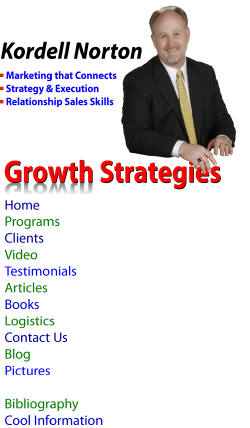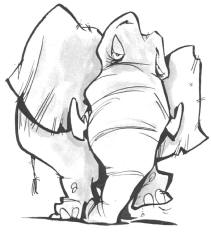

 Account Review Sessions
Account Review Sessions
or
“Who wouldn’t want to go to Pebble Beach with an Elephant?”
By Kordell Norton, copyright 2007, all rights reserved
The stage for the event was Monterey, California and its beautiful coast line. Let me bring you up to speed.
It started as a small Lilliputian effort and then morphed into a giant. In the 1990’s the personal computer market was brutal. The sellers of these little productivity tools were fighting a tough battle. If a PC reseller had just one quarter of red ink, within 18 months they were almost without exception bankrupt, sold out or merged with another entity. Size didn’t matter either. Ever hear of Sears Business Systems?
During this time the competition was vicious.
It was during this time period that I worked for one of the surviving PC resellers. To make sure we were in lock step with our customers we started Account Review Sessions. These sessions started small as a way to get feedback from customers and grew to be a huge strategic advantage. Why?
The Law of Attraction was one reason. In school you were taught that opposites attract. That is a truth in magnetism but outside the draw of positive and negative charges to each other, the rest of the world practices a different principle. That principle is the Law of Attraction . . . that “likes” are attracted to each other. Doctors like to be around doctors, criminals’ accomplice other criminals, movie stars flutter around flash bulbs in flocks, and winners like eagles, flock together.
Our customers also bought from us for different reasons, especially the bigger corporate clients. Winners like to be around winners. To keep dialog open with them and their specific “hot buttons” we started to meet with our key customers on a scheduled base to conduct Account Review Sessions. These review sessions played to the strongest definitions of “partnering”.
These sessions were so successful that the organization saw huge potential for using them to hone the corporation’s capabilities and to even attract new business. As time went by the process was honed and moved to a higher levels of execution.
So back to Monterey, California, and the Pebble Beach Golf Resort and Account Review Sessions on steroids.
Picture a meeting at a plush golf resort with our CEO and Chairman, and two or three executives from each of our largest customers. The meeting was a two day conversation with afternoons of golf. In addition there were a couple of prospective “non-customers” from other Fortune 100 companies and a consultant to facilitate the conversation.
The morning started with discussion on the meaning of Customer Sacrifice. As the discussion turned to what things they the customers felt they had to sacrifice to get what they wanted, the note pads of the Chairman and the CEO started to fill with insights and potential directions. Then when everyone was of a common mind on what was needed, lunch arrived just before the tee times. Those customers headed out to the links with their “fellow travelers”, singing the praises of the event and our organization’s capabilities. By the end of the event the customers were now great customers, and the prospects were converts. The Chairman and CEO also had pages of notes of those things that would put the company light years ahead of the competition.
What? You don’t have the money to go to Pebble Beach? Maybe not, but you should be doing Account Review Sessions on a smaller scale with your current customers. Which ones? The top twenty percent who account for the 80% of your business.
Hugging the Elephant.
The term “Hug the Elephant” is appropriate here. The bigger the account, the larger the elephant, the more people it takes to hold hands so that you can “hug the elephant”.
What does an account review session look like?
1. Location.
It is generally held away from phones, interruptions, meetings, bosses, and subordinates.
2. The right people are at the table.
In attendance are the sales representatives, the sales support staff, the manager, the finance person over the account, the technical support person in fact, anyone who is involved with the customers business. Of course the Law of Attraction applies here as well. The “honcho” from the customer will want to have a conversation with your senior executives; the person who places orders will want to talk to the person who processes orders.
3. A DRASTIC Event needs to be staged.
See the book, “Throwing Gas on the Fire, creating drastic change in sales and marketing” written by the author. To make your Account Review Session powerful, make sure you orchestrate all the elements of D.R.A.S.T.I.C. to bring about change and ever higher partnership and sales. Read he book!
4. Room Set up
Easel, markers, pads of paper, pens, refreshments, control of the temperature, a safe place for the customers coats, briefcases, etc. (the LAST thing you want is your customer going to get their coat and it is gone). Make sure you have any and all tools you might need for a functional meeting. If you need copies of something that is critical, do you know where the copier is? What about coaching the kitchen staff or hotel personnel so they don’t enter at the wrong time?
5. Preparation
You will want to consider reports, information, marketing pieces, and samples. Be careful of PowerPoint presentations. The purpose of this meeting is to discuss and dialog. If you are subjecting your customer to a PowerPoint marathon, you are missing the point of the event. Make sure you get a copy of the agenda to the customer before hand so they can buy into the meeting content.
6. Guidelines and Steps for an Account Review Session Agenda
Cover the following agenda items and steps.
1. “Thank you for the business you have given us.”
How often is information communicated to the customer? Years ago I heard the Chairman of a billion dollar company say to his vendor, “last year we did in excess of six hundred million dollars in business with you, and this is the first time I ever recalled being thanked for the business.” The supplier was floored and embarrassed to say the least.
2. Pass out the shirts and trinkets. (again. . .read the book, Throwing Gas on the Fire, creating drastic change in sales and marketing by the author)
3. Review the business for the last year. Make sure the discussion involves all those in your organization and their organization who are involved in the business. Look at the business by volume, by project, by products, by division, by solutions, by customer focus, etc. Make sure you have the data, reports, and information.
4. Discussion the negatives, problems and obstacles related to the business. Make sure these are flip charted so they can be transcribed and put into note form for future meetings and follow up.
5. The pluses and pros of the business relationship. Why? You want them resold on you and your capabilities after all the negatives above. You also need the others who are in attendance to get this feedback in this mental pay day.
6. The Future – Yours. This is the place to share you future directions, products, organization changes, advertising programs, new services.
7. The Future – The Customers. This whole event is all about them and their needs. Change is inevitable. You might as well find out what their needs are going to be in the coming months and years. “Skate to where the puck is going to be” said Wayne Gretzky. What are their product directions, personal plans, where is their competition going, what new service offerings are they pursuing, what equipment is going to be purchased, what new executives do they now have on board and what impact will those individuals have on the business?
8. Problems – Theirs. Make sure you get their biggest issues put on a flipchart. Not only those that are associated with your products and services, but also the bigger problems they are experiencing in their business. Why? There may be a chance that your products and services may be able to help them in other areas, cementing the relationship further. But even if you your offerings can’t help, you may have a partner, friend or other network contact that could help.
Recently I was having a discussion with a customer as we walked by a rack of parts that he used in his business. I asked him where he bought them. He frowned and indicated a far off city and commented about the cost of freight he knew he was paying. He went on to say that since he bought the company, every one was so busy that they didn’t even have time to find a local source for the parts. The next day I was in front of the president of a local manufacturer who made the exact same parts. I coached the second executive to call the first and pursue being a supplier. The call occurred, a new relationship made and money saved.
9. Talk about your customer’s customer. You don’t become a partner until you truly understand the customer’s customer and the problems that those “end users” faces. Once you understand how your products help your customer’s business, then you start to think in terms of what is best for the ultimate consumer. When you think that way your customer will become vary aware of the partnership.
10. Make a list of the To-Do’s and assignments from the discussion and review those. Make a tentative appointment for the next meeting. You might as well cement the relationship for that long.
11. IMPORTANT STEP!!!!!!. Think about the following in a non manipulative way. If you don’t really feel the emotion of the following suggestion THEN DON’T SAY IT. Other wise you will sound phony and insincere and your customer will be able to tell. You will have impacted the trust of the relationship.
You will want to say something like, “This has been a great conversation. We really appreciate you as a partner and a leader. We wish all of our customers were as insightful, fun and professional as you are. Based on that, I have a question for you? Who do you know who is as sharp as you guys that we ought to be doing business with? Is there some organization or person that we are missing the boat on by not doing pursuing a business relationship? (Wait for the answer . . . . don’t say anything . . . let them think.
12. “Thank you again for your business!”
About Kordell Norton - The Top Line Guy
Your organization has a strong interest in the "top line" for growth. As a consultant, speaker, author, Kordell Norton works with corporate, association, education and government organizations who want to focus on branding, sales, marketing, strategic planning/leadership, team building, and customer service.
Kordell was an executive with several multi-billion dollar corporations with executive suite positions in sales, HR, marketing and call centers. As a certified Graphic Facilitator, he uses highly visual processes, along with humor, and entertaining methods for powerful, high energy presentations.
Author of Throwing Gas on the Fire - creating drastic change in Sales and Marketing
He can be reached at (330) 405-1950 or at kordell@kordellnorton.com or at his website - www.KordellNorton.com